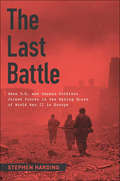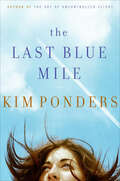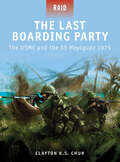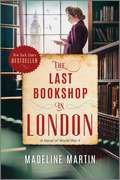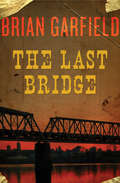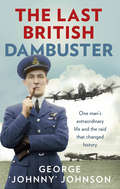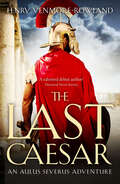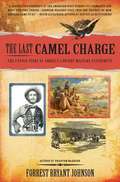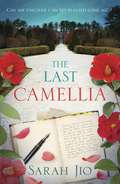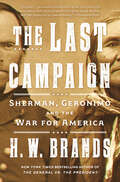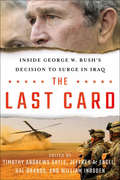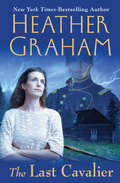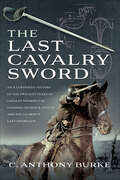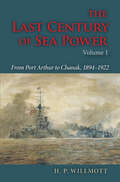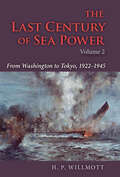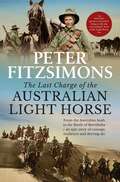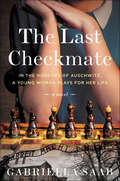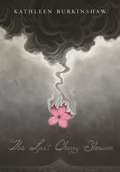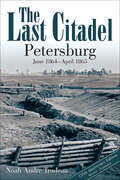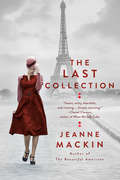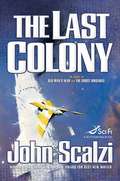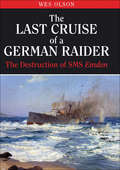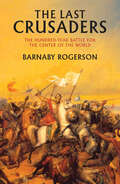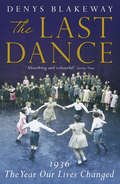- Table View
- List View
The Last Battle: When U.S. and German Soldiers Joined Forces in the Waning Hours of World War II in Europe
by Stephen HardingThe true story of US & German soldiers fighting side by side in the final days of WW II
The Last Blue Mile: A Novel
by Kim Ponders18-year-old Brook Searcy has just begun her first year at the Air Force Academy. Abandoned by her mother and raised by a loving yet distant father, Brook has surprised her traditional East Coast family by deciding to enter a completely foreign world -- the military. At the Academy she encounters both friends and terrifying foes, and experiences both first love and terrible loss as her relationships with her fellow cadets grow. Commandant John Waller, a former fighter pilot, has made the Air Force his life for nearly twenty years. His career couldn-t be in better shape, but he finds himself drifting away from his wife and daughters. And when a new (and female) Superintendent who-s never flown a plane becomes Waller-s new boss, he worries that the institution that he-s shaped his life around might be slipping away as well.Over the course of two years, terrible scandals and heartbreaking tragedy touch both Brook and Waller-s lives -- forcing them to make wrenching decisions that will shape both their careers and their lives.
The Last Boarding Party - The USMC and the SS Mayaguez 1975
by Steve Noon Clayton ChunOn April 30, 1975, the final curtain of America's long involvement in the Vietnam War fell. North Vietnamese forces captured Saigon while thousands of South Vietnamese refugees attempted to flee on foot, boat, and aircraft. The American public believed that the events in Southeast Asia had finally come to a bitter end. Less than two weeks later, President Gerald Ford ordered air, naval, and Marine forces to conduct combat operations in waters off Cambodia. On May 12, communist Cambodian Khmer Rouge elements seized the S.S. Mayaguez, an American merchant ship, and its crew in international waters. This act of piracy created an incident where U.S. Marine Corps elements attempted to rescue the Mayaguez, one of the most controversial raids in recent history. This book will track every development in the mission , an eventual success that demonstrated American resolve to use military forces in foreign policy issues after the Vietnam debacle.From the Trade Paperback edition.
The Last Bookshop in London: A Novel of World War II
by Madeline MartinThe New York Times bestseller—for fans of All the Light We Cannot See and The Tattooist of Auschwitz!&“An irresistible tale which showcases the transformative power of literacy, reminding us of the hope and sanctuary our neighborhood bookstores offer during the perilous trials of war and unrest.&”—KIM MICHELE RICHARDSON, author of The Book Woman of Troublesome CreekAugust 1939: London prepares for war as Hitler&’s forces sweep across Europe. Grace Bennett has always dreamed of moving to the city, but the bunkers and drawn curtains that she finds on her arrival are not what she expected. And she certainly never imagined she&’d wind up working at Primrose Hill, a dusty old bookshop nestled in the heart of London.Through blackouts and air raids as the Blitz intensifies, Grace discovers the power of storytelling to unite her community in ways she never dreamed—a force that triumphs over even the darkest nights of the war.&“A gorgeously written story of love, friendship, and survival set against the backdrop of WWII-era London.&”—JILLIAN CANTOR, author of In Another Time and Half Life&“A love letter to the power of books to unite us, to hold the world together when it&’s falling apart around our ears. This fresh take on what London endured during WWII should catapult Madeline Martin to the top tier of historical fiction novelists.&”—KAREN ROBARDS, author of The Black Swan of ParisDon't miss Madeline Martin's next heartwarming historical novel, The Booklover's Library!Also by Madeline Martin: The Librarian Spy The Keeper of Hidden Books
The Last Bridge
by Brian GarfieldA crack team of American specialists makes a deadly run into North VietnamCliffs hang over the rail bridge that crosses the Sang Chu River, protecting the vital North Vietnamese supply line from attack by American bombers. It&’s only accessible by a parachute drop that would put American GIs deep behind enemy lines. No point on the Ho Chi Minh Trail is more crucial to the Viet Cong war effort, and nowhere is more tightly guarded. Colonel David Tyreen has just sent a team to destroy the bridge, and none returned. It&’s time to assemble another team. The weather is awful, and the only plane available is a rickety old captured jet. Tyreen&’s mission is suicide, pure and simple, and he asks only for volunteers. The eight men who sign on have nothing to fear from death. This is lucky, for death approaches with all the speed of the swirling Sang Chu current.
The Last British Dambuster: One man's extraordinary life and the raid that changed history
by George Johnny MBEJohnny Johnson has been awarded an MBE for his remarkable services in World War II'I was anxious to fight. Hitler was the bastard who had started all this and he needed sorting out. We were under threat. Everything we stood for: our country, our families and our way of life was being attacked by this maniac. He could not be allowed to win. So for me and many, many others like me, there was no alternative. We were in a pickle and something had to be done.’Johnny Johnson is 95 years old and one of very few men who can recall first-hand the most daring and ingenious air raid of all time. He can also vividly remember his childhood spent working on a farm with his controlling father, the series of events that led him to the RAF and the rigorous training that followed. But it was his decision to join 617 Squadron, and the consequences, that have truly stayed etched in his mind. On 16 May 1943, Johnny, alongside 132 specially selected comrades, took off from Scampton airbase in Lincolnshire. For six weeks they had been trained to fulfil one mission that was near impossible: to destroy three dams deep within Germany’s Ruhr Valley. It was a daring task but, against the odds, Johnny and his crew survived. Sadly, 53 comrades did not.For the first time, Johnny relives every moment of that fatal night – and the devastating aftermath. He recalls with unique wit and insight the difficult training conducted in secrecy, the race against time to release the bombs, and the sheer strength and bravery shown by a small unit faced with great adversity and uncertainty. Embodying a whole squadron, and leaving a lasting legacy for generations to come, Johnny’s story is like no other.
The Last Caesar (The Aulus Severus Adventures)
by Henry Venmore-RowlandAs Emperor Nero casts his madness over Rome, a loyal soldier is caught in a conspiracy that threatens the empire in this historical epic. Rome, 68 AD: The tyrant emperor Nero has no heir, and whispers of rebellion are spreading fast. As Rome faces the possibility of becoming a republic once more, the ambitions of a few are about to bring untold corruption, chaos, and bloodshed. Aulus Caecina Severus, hero of the campaign against Boudica, has become part of a conspiracy to overthrow Caesar&’s dynasty. But is it really all for the good of Rome? The boundary between service and self-preservation is far from clear, and navigating this dangerous path requires all Severus&’ skills: as a cunning soldier and, increasingly, a deft politician. As the Year of the Four Emperors unfolds, the mighty Roman empire will be plunged into anarchy and civil war . . .
The Last Camel Charge
by Forrest Bryant JohnsonIn the mid-nineteenth century, the U.S. Army was on the verge of employing a weapon that had never before been seen on its native soil: a cavalry mount that would fare better than both mules and horses in the American Southwest... Against the Mojave in the Arizona Territory, against the Mormons in Utah Territory, during the early stages of the Civil War, the camel would become part of military history and a nearly forgotten chapter of Americana. This is the true story of that experiment and the extraordinary group of people who it brought together. The Last Camel Charge gives them their due as a vital piece of American history. INCLUDES PHOTOS
The Last Camellia
by Sarah Jio'I adore Sarah Jio's novels.' Santa MontefioreA haunting story of love, family and the secrets that can destroy us... 1933. Vera Ray kisses her young son goodnight and leaves to work the night-shift at a local hotel. The next morning, she discovers an sudden snowfall has blanketed the city, and her son has vanished, the snow covering up any trace of his tracks, or the perpetrator's.2010. Journalist Claire Aldridge has been burying herself in work to avoid her own pain. When she is assigned to cover the 'blackberry winter' storm she learns of the disappearance of a three-year-old boy. He was never found. Claire vows to find the truth, but as she immerses herself in the mysteries of the past, Claire discovers that not all secrets should be revealed.An emotional story of a mother's love, a missing child and the search for the truth. Perfect for fans of Kathryn Hughes, Lucinda Riley and Tracy Rees.
The Last Campaign: Sherman, Geronimo and the War for America
by H. W. BrandsBestselling historian and Pulitzer Prize finalist H. W. Brands follows the lives of General William Tecumseh Sherman and Apache war leader Geronimo to tell the story of the Indian Wars and the final fight for control of the American continent.William Tecumseh Sherman and Geronimo were keen strategists and bold soldiers, ruthless with their enemies. Over the course of the 1870s and 1880s these two war chiefs would confront each other in the final battle for what the American West would be: a sparsely settled, wild home where Indian tribes could thrive, or a more densely populated extension of the America to the east of the Mississippi.Sherman was a well-connected son of Ohio who attended West Point and rose to prominence through his scorched-earth campaigns in the Civil War. Geronimo grew up among the Apache people, hunting wild game for sustenance and roaming freely on the land. After the brutal killing of his wife, children and mother by Mexican soldiers, he became a relentless avenger, raiding Mexican settlements across the American border. When Sherman rose to commanding general of the Army, he was tasked with bringing Geronimo and his followers onto a reservation where they would live as farmers and ranchers and roam no more. But Geronimo preferred to fight.The Last Campaign is a powerful retelling of a turning point in the making of our nation and a searing elegy for a way of life that is gone.
The Last Card: Inside George W. Bush's Decision to Surge in Iraq
This is the real story of how George W. Bush came to double-down on Iraq in the highest stakes gamble of his entire presidency. Drawing on extensive interviews with nearly thirty senior officials, including President Bush himself, The Last Card offers an unprecedented look into the process by which Bush overruled much of the military leadership and many of his trusted advisors, and authorized the deployment of roughly 30,000 additional troops to the warzone in a bid to save Iraq from collapse in 2007.The adoption of a new counterinsurgency strategy and surge of new troops into Iraq altered the American posture in the Middle East for a decade to come. In The Last Card we have access to the deliberations among the decision-makers on Bush's national security team as they embarked on that course. In their own words, President George W. Bush, Vice President Dick Cheney, National Security Advisor Stephen Hadley, Secretary of State Condoleezza Rice, White House Chief of Staff Joshua Bolten, Secretary of Defense Robert Gates, and others, recount the debates and disputes that informed the process as President Bush weighed the historical lessons of Vietnam against the perceived strategic imperatives in the Middle East. For a president who had earlier vowed never to dictate military strategy to generals, the deliberations in the Oval Office and Situation Room in 2006 constituted a trying and fateful moment.Even a president at war is bound by rules of consensus and limited by the risk of constitutional crisis. What is to be achieved in the warzone must also be possible in Washington, D.C. Bush risked losing public esteem and courted political ruin by refusing to disengage from the costly war in Iraq. The Last Card is a portrait of leadership—firm and daring if flawed—in the Bush White House.The personal perspectives from men and women who served at the White House, Foggy Bottom, the Pentagon, and in Baghdad, are complemented by critical assessments written by leading scholars in the field of international security. Taken together, the candid interviews and probing essays are a first draft of the history of the surge and new chapter in the history of the American presidency.
The Last Cavalier
by Heather GrahamA Confederate soldier plunges through a portal in time . . . into the future and into the arms of a modern woman Confederate cavalry captain Jason Tarkenton is fighting the battle of his life, desperate to save his fellow comrades-in-arms from their hated Yankee enemies. Suddenly, he hears a thunderous crack in the sky. The earth beneath his feet begins to shift as he is engulfed in darkness and mist. Virginian Vickie Knox has spent most of her life listening to her grandfather&’s tales about the Civil War. To humor his obsession, she agrees to don authentic garb for their farming town&’s reenactment of a battle. But the stranger in rebel uniform who accosts her and takes her captive isn&’t part of the festivities. He&’s the real deal—a soldier in Robert E. Lee&’s army who left unfinished business back in 1862. Neither of them expects to fall in love. If Jason returns to the past, he could change the course of history—and risk losing Vickie forever. Unless she is willing to gamble her future on a love stronger than time itself . . . This ebook features an illustrated biography of Heather Graham, including rare photos from the author&’s personal collection.
The Last Cavalry Sword: An Illustrated History of the Twilight Years of Cavalry Swords (UK) General George S. Patton and the US Army's Last Sword (US)
by Anthony C. BurkeThis book tells the story of the last sword ever designed by a major power for its army to use as a weapon, not as an article of a dress uniform. The sword was the U.S. Model 1913 Cavalry Saber; the designer was George S. Patton, then a lieutenant on the staff of the Army chief of staff. Patton participated in the modern pentathlon in Stockholm in 1912, which included fencing, coming fifth overall. No one in the U.S. Army could be better suited, therefore, to design its last major edged weapon. The Last Sword provides an illustrated overview of the history of cavalry swords and their employment on the battlefield from the end of the Renaissance, through the Napoleonic Era, the Mexican-American War, the Civil War, the Spanish-American War, culminating with the Patton cavalry saber, and includes descriptions of a number of the more famous cavalry charges. Patton’s unswerving belief in the value of horse-mounted cavalry, and in the value of those troopers and officers being equipped with the sword he designed, is described using his own words. He continued to advocate horse-mounted cavalry right up to the start of the Second World War. Though mechanized squadrons replaced the conventional cavalry, it was not quite the end of Patton’s sword as some Model 1913 Cavalry Sabers were converted to fighting knives carried by GIs during the war. The book is fully illustrated with images from the collections of the Smithsonian Institution Museum of American History, the Library of Congress, the General George S. Patton Museum, the National Museum of the U.S. Army, the Connecticut Historical Society, and from private collections, most of which have never been published before.
The Last Century of Sea Power, Volume 1: From Port Arthur to Chanak, 1894–1922 (The Last Century of Sea Power #1)
by H. P. Willmott“In this first of three volumes on sea power, the author reviews the story of political, economic, and military oceanic control from the 1890s through WWI.” —ChoiceThe transition to modern war at sea began during the period of the Sino-Japanese War (1894–1895) and the Spanish-American War (1898) and was propelled forward rapidly by the advent of the dreadnought and the nearly continuous state of war that culminated in World War I. By 1922, most of the elements that would define sea power in the 20th century were in place.Written by one of our foremost military historians, this volume acknowledges the complex nature of this transformation, focusing on imperialism, the growth of fleets, changes in shipbuilding and armament technology, and doctrines about the deployment and use of force at sea, among other factors. There is careful attention to the many battles fought at sea during this period and their impact on the future of sea power. The narrative is supplemented by a wide range of reference materials, including a detailed census of capital ships built during this period and a remarkable chronology of actions at sea during World War I.“The author, dean of naval historians, provides a sweeping look at, and analysis of, the transformation of naval power . . . [His] dry wit and sense of irony add spice to the impressive array of facts and analysis of the greatest period of naval warfare. Wilmott is fearless in his judgments.” —Seapower“This book, first of a series, contains a wealth of facts and opinions, the latter provided with Willmott’s unerring analytical eye and mordant wit.” —Bernard D. Cole, National War College
The Last Century of Sea Power, Volume 2: From Washington To Tokyo, 1922-1945 (The Last Century of Sea Power #2)
by H. P. WillmottIn this second volume of his history of naval power in the 20th century, H. P. Willmott follows the fortunes of the established seafaring nations of Europe along with two upstarts--the United States and Japan. Emerging from World War I in command of the seas, Great Britain saw its supremacy weakened through neglect and in the face of more committed rivals. Britain's grand Coronation Review of 1937 marked the apotheosis of a sea power slipping into decline. Meanwhile, Britain's rivals and soon-to-be enemies were embarking on significant naval building programs that would soon change the nature of war at sea in ways that neither they nor their rivals anticipated. By the end of a new world war, the United States had taken command of two oceans, having placed its industrial might behind technologies that further defined the arena of naval power above and below the waves, where stealth and the ability to strike at great distance would soon rewrite the rules of war and of peace. This splendid volume further enhances Willmott's stature as the dean of naval historians.
The Last Charge of the Australian Light Horse: From the Australian bush to the Battle of Beersheba - an epic story of courage, resilience and derring-do
by Peter FitzSimonsOn 31st October 1917, as the day's light faded, the Australian Light Horse charged against their enemy. Eight hundred men and horses galloped four miles across open country, towards the artillery, rifles and machine guns of the Turks occupying the seemingly unassailable town of Beersheba. What happened in the next hour changed the course of history.This brave battle and the extraordinary adventures that led to it are brought vividly to life by Australia's greatest storyteller, Peter FitzSimons. It is an epic tale of farm boys, drovers, bank clerks, dentists, poets and scoundrels transported to fight a war half a world away, and is full of incredible characters: from Major Banjo Paterson to Lawrence of Arabia; the brilliant writer Trooper Ion Idriess and the humble General Harry Chauvel; the tearaway Test fast bowler 'Tibby' Cotter and the infamous warhorse, Bill the Bastard. All have their part to play in the enthralling, sprawling drama of the Australian Light Horse.Theirs was a war fought in an ancient land with modern weapons; where the men of the Light Horse were trained in sight of the pyramids, drank in the brothels of Cairo and fought through lands known to them only as names from the Bible.The Last Charge of the Australian Light Horse traces the hard path of the Light Horse from the bleakest of starts - being deprived of their horses and fighting at Gallipoli in the tragic Battle of the Nek - to triumph and glory in the desert. Revealing the feats of the Australians who built the legend, it is a brilliantly told tale of courage, resilience and derring-do from Australia's favourite storyteller.
The Last Checkmate: A Novel
by Gabriella SaabA young Polish woman imprisoned in Auschwitz plays chess in exchange for her life in this &“smart and haunting&” WWII novel (New York Times–bestselling author Patti Callahan). A PopSugar Best Book of the Year! Maria Florkowska is many things: daughter, avid chess player, and, as a member of the Polish resistance in Nazi-occupied Warsaw, a young woman brave beyond her years. When she is captured with her family by the Gestapo, she also becomes a prisoner of Auschwitz. While Maria&’s parents are sent to their deaths, the sadistic camp deputy Karl Fritzsch is intrigued by her chess skills and spares her life. But only for so long as he cares to play against her. Overcome with grief, Maria vows to avenge her parents—a vow that makes her fight for her own survival. For four grueling years, Maria uses chess to get inside Fritzsch&’s head and orchestrate his downfall. It&’s a game of the highest stakes. And there can be only one winner.
The Last Cherry Blossom
by Kathleen BurkinshawFollowing the seventieth anniversary of the atomic bombing of Hiroshima, this is a new, very personal story to join Sadako and the Thousand Paper Cranes.Yuriko was happy growing up in Hiroshima when it was just her and Papa. But her aunt Kimiko and her cousin Genji are living with them now, and the family is only getting bigger with talk of a double marriage! And while things are changing at home, the world beyond their doors is even more unpredictable. World War II is coming to an end, and since the Japanese newspapers don’t report lost battles, the Japanese people are not entirely certain of where Japan stands. Yuriko is used to the sirens and the air-raid drills, but things start to feel more real when the neighbors who have left to fight stop coming home. When the bombs hit Hiroshima, it’s through Yuriko’s twelve-year-old eyes that we witness the devastation and horror.This is a story that offers young readers insight into how children lived during the war, while also introducing them to Japanese culture. Based loosely on author Kathleen Burkinshaw’s mother’s firsthand experience surviving the atomic bombing of Hiroshima, The Last Cherry Blossom hopes to warn readers of the immense damage nuclear war can bring, while reminding them that the "enemy” in any war is often not so different from ourselves.
The Last Citadel: Petersburg, June 1864–April 1865
by Noah Andre TrudeauThe revised and updated groundbreaking study of the most extensive military operation of the Civil War—from the author of Bloody Roads South.The Petersburg campaign began on June 9, 1864, and ended on April 3, 1865, when Federal troops at last entered the city. It was the longest and most costly siege ever to take place on North American soil, yet it has been overshadowed by other actions that occurred at the same time period, most notably Sherman’s famous “March to the Sea,” and Sheridan’s celebrated Shenandoah Valley campaign. The ten-month Petersburg affair witnessed many more combat actions than the other two combined, and involved an average of 170,000 soldiers, not to mention thousands of civilians who were also caught up in the maelstrom. By its bloody end, the Petersburg campaign would add more than 70,000 casualties to the war’s total.With the same dogged determination that had seen him through the terrible Overland Campaign, Lieutenant General Ulysses S. Grant fixed his sights on the capture of Petersburg. Grant’s opponent, General Robert E. Lee, was equally determined that the “Cockade City” would not fall. Trudeau crafts this dramatic and moving story largely through the words of the men and women who were there, including officers, common soldiers, and the residents of Petersburg. What emerges is an epic account rich in human incident and adventure. Based on exhaustive research into official records and unpublished memoirs, letters, and diaries, as well as published recollections and regimental histories, The Last Citadel also includes twenty-three maps and a choice selection of drawings by on-the-spot combat artists.
The Last Collection: A Novel of Elsa Schiaparelli and Coco Chanel
by Jeanne MackinAn American woman becomes entangled in the intense rivalry between iconic fashion designers Coco Chanel and Elsa Schiaparelli in this captivating novel from the acclaimed author of The Beautiful American.Paris, 1938. Coco Chanel and Elsa Schiaparelli are fighting for recognition as the most successful and influential fashion designer in France, and their rivalry is already legendary. They oppose each other at every turn, in both their politics and their designs: Chanel’s are classic, elegant, and practical; Schiaparelli’s bold, experimental, and surreal.When Lily Sutter, a recently widowed young American teacher, visits her brother, Charlie, in Paris, he insists on buying her a couture dress—a Chanel. Lily, however, prefers a Schiaparelli. Charlie’s beautiful and socially prominent girlfriend soon begins wearing Schiaparelli’s designs as well, and much of Paris follows in her footsteps. Schiaparelli offers budding artist Lily a job at her store, and Lily finds herself increasingly involved with Schiaparelli and Chanel’s personal war. Their fierce competition reaches new and dangerous heights as the Nazis and the looming threat of World War II bear down on Paris.
The Last Colony
by John ScalziThird in the series begun with Old Man's war. John Perry, hero of Old Man's War, is back. He has retired to a peaceful farming planet to live out the remainder of his life. But then he and his wife are asked to lead the colony being established on the planet roanoke. Needless to say, all is not what is schemes -- lots of intrigue, hostile aliens, action... what more could one want? According to the author, this is the last book in this particular "universe" for a while.
The Last Cruise of a German Raider: The Destruction of SMS Emden
by Wes OlsonThe story of the German light cruiser SMS _Emden_ has been the subject of over a dozen books since her destruction at the hands of the Australian light cruiser HMAS _Sydney_ on 9 November 1914. Accounts of _Emden_s raiding activities, her loss on the Cocos Islands, and the escape of her landing party have also appeared in official histories and books on the First World War at sea. No English-language book, however, has pieced together a comprehensive account of the action and the events before and after.In this detailed and riveting new book, Wes Olson has made extensive use of a wealth of first-hand accounts from letters, diaries, memoirs and German survivor statements to produce a detailed reconstruction of the battle at Cocos. By breaking the one-and-a-half-hour action down into ten-minute blocks an accurate, chronological and credible picture has been created, and the extensive use of quotations gives the story a unique vividness.But the book is much more than the account of one naval battle. _The Emden_s activities as a raider at the beginning of the war are outlined; the significance of the departure of the first ANZAC troop convoy, and _Sydneys_ involvement explained. The Cocos raid and the landing of von Mckes party and the dispatch of _Sydney_ to investigate are covered, and Captain Glossops controversial decision to open fire on the wreck of the _Emden_ is analysed. And drawing on the reports produced by Sydneys surgeons, the book presents a facet of naval action often overlooked namely the effect of high explosive shells on the human body.Employing the wealth of archival and photographic material, as well as the numerous first-hand accounts of the German, British and Australian participants, the author has written a work that takes the reader right to the centre of the action and brings alive the immediacy and horror of naval warfare for those who took part.
The Last Crusaders: The Hundred-Year Battle for the Center of the World
by Barnaby RogersonThe acclaimed Medieval historian examines how the crusades of the fifteenth and sixteenth centuries reshaped the Mediterranean and influenced the globe. In the late Middle Ages, the forces of Christianity engaged in a series of epic battles with the Ottoman Empire. Though these later crusades are often overshadowed by earlier conflicts, they hold profound historical significance. They were the bridge between the medieval and modern periods, between feudalism and colonialism.The Last Crusaders is about this period&’s last great conflict between East and West. From the great naval campaigns and the ferocious struggle to dominate the North African shore, the hostility spread along trade routes, consuming nations and cultures, destroying dynasties, and spawning the first colonial empires in South America and the Indian Ocean.&“Rogerson's narrative colors the conflicts of the sixteenth century with the derring-do of kings, corsair, and crusaders; this book will keep readers up long past bedtime.&” —Foreword Magazine
The Last Dance: 1936: The Year Our Lives Changed
by Denys Blakeway'The year has, indeed, begun in gloom. The King ill, and Kipling dead ...' so wrote the diarist Chips Channon in 1936 as George V lay on his deathbed at Buckingham Palace. The passing of two such pillars of the establishment sent tremors through the nation and heralded the ending of the old order. 1936 was to be an extraordinary year: at home social and constitutional crisis threatened, while in Europe, the dictators were on the march. It was the year of the abdication and civil war in Spain. The tectonic plates of history were shifting - Britain would never be the same again. The Last Dance is told using the accounts of those who lived through this turbulent period. Through extracts from diaries of shopkeepers, socialites, bishops, and volunteers in Spain, and the memoirs of the unemployed, housewives and hostesses, as well as the contemporary accounts of politicians, journalists and poets, Blakeway offers a compelling and vivid account of a turning point in our nation's story.
The Last Dance: 1936: The Year Our Lives Changed
by Denys Blakeway'The year has, indeed, begun in gloom. The King ill, and Kipling dead ...' so wrote the diarist Chips Channon in 1936 as George V lay on his deathbed at Buckingham Palace. The passing of two such pillars of the establishment sent tremors through the nation and heralded the ending of the old order. 1936 was to be an extraordinary year: at home social and constitutional crisis threatened, while in Europe, the dictators were on the march. It was the year of the abdication and civil war in Spain. The tectonic plates of history were shifting - Britain would never be the same again. The Last Dance is told using the accounts of those who lived through this turbulent period. Through extracts from diaries of shopkeepers, socialites, bishops, and volunteers in Spain, and the memoirs of the unemployed, housewives and hostesses, as well as the contemporary accounts of politicians, journalists and poets, Blakeway offers a compelling and vivid account of a turning point in our nation's story.
